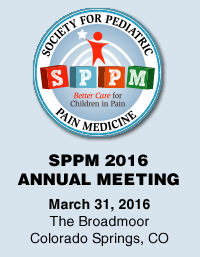American Academy of Pediatrics Update
 Rita Agarwal MD
Rita Agarwal MD
Chair, AAP Section of Anesthesiology and Pain Medicine (SOA)
Jennifer Riefe M.Ed
Manager, AAP Section of Anesthesiology and Pain Medicine
Members of the AAP and the SPPM have many goals and interests in common. For that reason we thought an update on the recent activities of the AAP and AAP Section on Anesthesiology and Pain Medicine would be of interest to the SPPM membership.
Here is a list of recent accomplishments and ongoing work:
Recently released or published:
- The AAP Section on Anesthesiology and Pain Medicine recently released a NEW Manual on Procedural Sedation for Infants, Children, and Adolescents
- In October 2015, the AAP submitted a formal letter to the FDA in response to a request for comments on the international scheduling of the drug ketamine, published in the Federal Register on October 5, 2015 (Docket No. FDA–2015–N–0045). The AAP asserted that Ketamine is an essential agent for sedation in children in the United States and throughout the world.
- January 25, 2016: Policy Statement on “Prevention and Management of Procedural Pain in the Neonate,” co-authored by the AAP Committee on Fetus and Newborn and the AAP Section on Anesthesiology and Pain Medicine (SOA). The full document can be accessed at: http://pediatrics.aappublications.org/content/pediatrics/early/2016/01/22/peds.2015-4271.full.pdf.
- As part of work related to the Providers' Clinical Support System for Opioid Therapies Grant from SAMHSA, the Section is working to develop a 6-part webinar series with the AAP Committee on Substance Abuse aimed at preventing, identifying, and treating opioid dependence. The first webinar, offered in July 2015, focused on the Neurobiology of Pain. The second webinar, offered in August 2015, focused on Strategies for Pain Management. Four additional webinars will be offered in the near future. Archived webinars can be viewed at: https://www.aap.org/en-us/about-the-aap/Committees-Councils-Sections/substanceabuse/Pages/PCSS-O.aspx.
In Progress:
- Revision of the Policy Statement on “The Assessment and Management of Acute Pain in Infants, Children, and Adolescents”
- New Policy Statement on “Care of Pediatric Patients with Chronic Pain”
- New Clinical Report on “Codeine and the Potential for Toxicity in the Pediatric Patient,” a joint Report with the Committee on Drugs (in final stages)
- Revision of the 2006 AAP/AAPD “Guidelines for Monitoring and Management of Pediatric Patients During and After Sedation for Diagnostic and Therapeutic Procedures” is underway. We expect that the new Guidelines will be published in Summer 2016.
- New online CME course on pediatric pain management, which will be made available on PediaLink, the AAP’s online learning platform by late summer/early fall 2016. The course will be designed to meet the needs of pediatricians in states where pain management CME is required for re-licensure. This course has been made possible by a grant from the AAP’s Friends of Children Fund.
- The AMA is currently working to develop a CME product for primary care providers on the topic of opioids. Our SOA Chairperson, Rita Agarwal, is participating as the AAP’s rep to the AMA Pain Management Expert Panel charged with managing this project. Their initial meeting took place in July 2015.
- In December 2015, the U.S. Food and Drug Administration (FDA) held a joint meeting of its Pulmonary-Allergy Drugs Advisory Committee and its Drug Safety and Risk Management Advisory Committee. During the portion of the meeting dedicated to public stakeholder input, Chair of the AAP’s Surgical Advisory Panel, Connie Houck, testified before the joint panel sharing the AAP’s recommendation that codeine and codeine-containing products be removed from the over-the-counter (OTC) cough and cold monograph for the treatment of cough in children, and that codeine be contraindicated for the treatment of both cough and pain in all children. The joint panel discussed the available data on the safety of codeine in children in three age groups – 0-6 years of age; 6-12 years of age; and 12 to 18 years of age – for both pain and cough. Following the discussion, the panel took votes on three questions related to the use of codeine in children, and the votes were overwhelmingly in favor of AAP’s recommendations.

